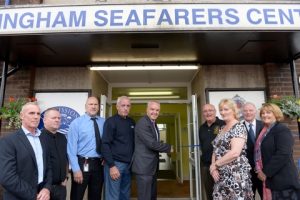
ABP Director Humber, John Fitzgerald performs the official opening with members of the ABP recovery team and Mission to Seafarers staff (image courtesy of Grimsby Telegraph)
A vital part of Immingham’s port community was officially reinstated recently with the opening of the Mission to Seafarers, which suffered tens of thousands of pounds-worth of damage in December’s tidal surge. The ceremony was performed by Associated British Ports’ (ABP) Director Humber, John Fitzgerald.
The Mission, which is run jointly by the Apostleship of the Sea and the Mission to Seafarers, was forced to close for nine months following the surge so the rooms could dry out and repairs and refurbishment could take place. ABP assisted in the days immediately following the event by providing manpower and resources, as well as a temporary base, so the rebuild could begin without disrupting the Mission’s valuable work, as ABP Director Humber John Fitzgerald explains.
He said: “It was a terrible night, but we were immensely thankful that no one was hurt and when faced with such tremendous adversity, people, including our own staff, pull together and achieve amazing things.
“The destruction of the centre felt like the soul of the port had been broken – it provides an extraordinary service for these unsung heroes, but as Colum and his team have demonstrated, out of the ashes opportunities arise, and this new and improved centre offers even better facilities for visiting crews.
“This is the UK’s most important port, with world-class terminals and it’s fitting that we now have a world-class seafarers centre.”
The Mission to Seafarers provides chaplaincy services and recreational facilities to visiting seafarers and is a vital lifeline for seafarers, many of whom may have been at sea for many weeks and months with no contact with family or friends.
It also offers free wifi and IT facilities, a well-stocked shop, games rooms and relaxation areas, and a chapel for quiet reflection. The chaplains also visit ships berthed at the port and often take seafarers on visits and they can also provide clothing and food for those in need.
Port Chaplain Father Colum Kelly described the events of the evening of the 5th December 2013 as ‘devastating’, but from the ruins of the building, he and his army of volunteers saw opportunity.
“I was devastated when I saw the building for the first time following the surge, ” said Colum. “The place was destroyed, but not only that, it was as if all of the joy and the happiness that the building had seen over the years, had been completely washed away by the flood waters.
“I stayed in the building throughout the project to oversee the work because when we decided to rebuild we were given the chance to make the centre even better than it was before, in fact we saw as our duty to do that.
“The staff here and many other businesses and individuals including ABP, made sure that was possible and the opening was full of exhilaration and joy. The UK’s number one port now has the UK’s number one seafarers centre.”
ABP is the UK’s leading ports operator with 21 ports and other transport related businesses creating a unique national network capable of handling a vast array of cargo.
Around one quarter of the UK’s seaborne trade passes through ABP’s Statutory Harbour Areas. ABP contributes £5.6 billion to the UK economy every year and supports 84, 000 jobs. Our current investment programme promises to deliver an extra £1.75 billion for the economy every year.
ABP…
- Handled over 1.5 million vehicles in 2013.
- Generates around one quarter of the UK’s rail freight
- Has 1.4 million square metres of covered storage
- Has 1000 hectares of open storage
- Handled 119m tonnes of cargo in 2013
- Owns 5000 hectares of port estate
- Has 87km of quay
Over the next five years, ABP is investing over £650 million in a wide range of major projects across the group.
ABP Humber
The four ports of Grimsby, Immingham, Hull and Goole handle more than 65 million tonnes of cargo between them each year.
Grimsby and Immingham form the UK’s busiest trading gateway and move around 54 million tonnes of cargo per annum.
£75 million is currently being invested in the biomass handling terminal in Immingham, in a Humber-wide agreement with Drax Power Ltd that has seen £25 million invested in a biomass handling facility in Hull. The Immingham Renewable Fuels Terminal will handle sustainable biomass shipments and will create over 100 permanent jobs once complete. The construction phase has also created 100 employment opportunities.
The Port of Hull handles 10 million tonnes of cargo per annum and is the is the focal point for the development of the UK’s largest offshore wind turbine construction, assembly, and service facility, which will be located on the Port’s Alexandra Dock. This new facility, coupled with a new rotor blade manufacturing base near Paull to the east of the port estate, represents a £310 million investment and could create up to 1000 direct jobs.
The Grimsby River Terminal represents an investment of £26 million and allows large car-carrying ships to berth outside the Port’s lock system. This development confirms the Port’s position as the UK’s leading automotive handling facility.
More than the equivalent of 1million teus (twenty foot equivalent unit) of unitised trade is shipped through ABP Humber ports.
Ro-ro and container traffic represents more than 30 sailings a week to Europe, Scandinavia the Baltic and beyond.
The Humber ports handle more than 70 freight train movements per day.
Goole is situated 50 miles upriver and is the UK’s premier inland port. It handles over two million tonnes of cargo annually.





